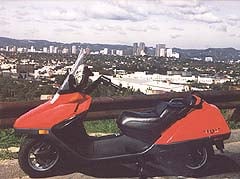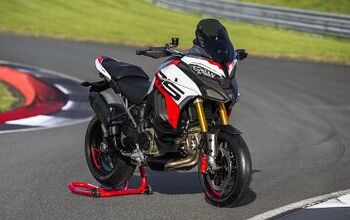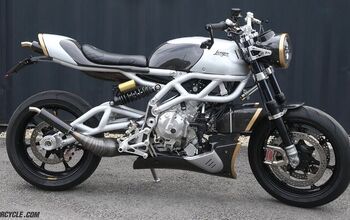First Impression: Honda Helix - Motorcycle.com
There is a story of three blind men who come across an elephant in the jungle. The first grabs its tail and says an elephant is like a rope. The second blind man feels the elephant's trunk and says the beast is shaped like a snake.
Meanwhile, the third blind man is touching the animal's leg and claims that an elephant is similar to a tree. If there is something for humble motorcycle testers to learn from this story, it is that we mustn't judge a bike by our initial impressions.
So it was with this "blind man's" viewpoint that I approached my new testbike, Honda's outrageous Helix.
A quick visual inspection will tell you this bike is a scooter because of its open floorboard area, automatic transmission and engine mounted over the rear wheel. Therefore it must be a scooter. But hold on, this machine has a wheelbase longer than a Harley dresser, a spacious trunk and huge seating area for two people. It must be a motorcycle.
So just what is a Helix? Is it the world's largest scooter, a smaller cousin to Honda's own Pacific Coast. Or does it defy pigeon-holing in any conventional category? To find out I decided to put the bike through my standard testing procedure to find out exactly where its strengths and weaknesses lay.
But before my two-wheeled torture test begins, let's look at the basics: Honda's Helix is powered by a 244cc four-stroke single and uses a V-Matic transmission to preclude the need for nasty things like a gear shifter and clutch lever. Starting is effortless - just step on the rear brake and push the start button, an automatic choke taking care of the rest.
Instruments are electronic and include a speedometer that reads in metric or imperial, a clock and gauges for temperature, oil level and fuel. Another gauge reminds Helix owners that it is nearing oil change time. Everything is laid out in an informative, non-threatening manner so as not to intimidate the biking neophyte. Really, if the Helix were any more user-friendly it would jump up on your leg.
"The Helix's light weight and flickable nature allows it to dart through the concrete jungle while leaving cage pilots trailing behind in the wake of its flatulent exhaust note."
Day one called for (don't laugh) top speed testing. Flat-out the Honda chuffs its way to a respectable 70 mph with a full tank of gas and a light lunch in me. This is an important number, as it means that Helix owners can brave highways without fear of being run down by speeding motorists. Still, an extra five mph or so would be nice for those impromptu top speed races with Winnebagos.
Day two on the Helix's test sheet called for a sound thrashing in the canyons. Not an appropriate venue for this machine? Maybe not, but no bike, whether it be scooter, tourer or sportbike passes through my torture test without canyon carving. Here the Helix was an able performer as its light weight and small tires made for extremely quick turn-ins and a fun afternoon in the twisties. Ground clearance was good as it took a decent effort to scrape the sidestand. Don't expect to sneak up on any sportbikes though, because the Helix's pogoing soft suspension limits the fun at, uh, higher speeds.
Day three and we're hitting the highways in search of touring fun. With its trunk stuffed with a camera bag, rainsuit and some extra clothes, the Helix is ready to roll. Unfortunately, pegging the throttle and battling hills and headwinds becomes frustrating after a while.
Wind protection from the large windscreen is substantial, although at highway speeds the vertical screen probably creates enough drag to lose five miles per hour. After miles of doing your best Scotty imitation, (She'll take na' more Cap'n!) you grow weary of highway travel. Just as well, as the Helix's small tank limits its range to around 100 miles (160 km) of top speed riding.
Day four and we're in the Helix's element - L.A. traffic. Maybe our beloved City of Angels didn't invent the traffic jam, but they damn well perfected it. It is here, splitting lanes and zipping through urban congestion that the Helix shines. Acceleration, even two-up, is enough to leave other motorists behind, and braking power from the hand-operated front brake and floorboard-mounted foot pedal is ample.
"60 miles per gallon while doing so is just an added bonus."
The Helix's light weight and flickable nature allows it to dart through the concrete jungle while leaving cage pilots trailing behind in the wake of its flatulent exhaust note. That its able to deliver 60 miles per gallon while doing so is just an added bonus. Plus its trunk is big enough for a few groceries or whatever else you need it for. Additional storage is available in the glove compartment, although it only offers enough room for a pack of Marlboros and a fake tattoo sticker.
So just what is a Helix? For $4,399 it's a practical everyday commuter, errand bike and even short-distance tourer. Honda's low-maintenance, uncomplicated method of transportation is an outrageous rolling statement that doesn't apologize for being 'just' a scooter.
Specifications:
Manufacturer: HondaModel: 1997 CN250 HelixPrice: ,399 (1996)Engine: liquid-cooled, four-stroke singleBore x stroke: naDisplacement: 244ccCarburetion: 30mm CV with automatic chokeTransmission: Automatic V-MaticWheelbase: 63.8 in.Seat height: 26.2 in.Fuel capacity: 3.2 gal.Claimed dry weight: 349.4 lbs
More by Gord Mounce, Associate Editor





























Comments
Join the conversation